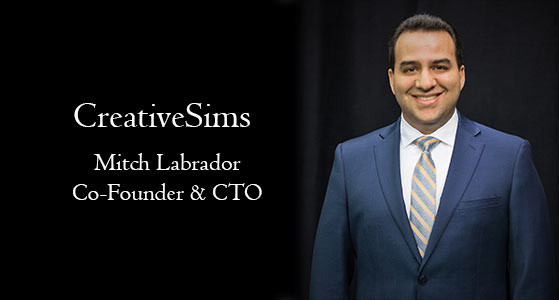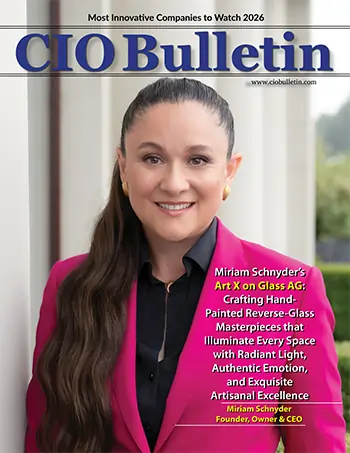50 Innovators of the Year 2021
CIO Bulletin

Learning has lately evolved a great deal and become more immersive, powered by premium technologies and innovation. Today, the world’s most valuable companies are employing immersive learning and simulation to boost the learning and engagement of their employees. The artificial or simulated techniques completely immerse a learner in the learning process and allow them to control the outcomes by exposing them to real experiences in a safe environment (minus the distractions!). These techniques are in a great way helping people learn faster and better. One of the companies acing the immersive training and simulation field is Creative Sims.
CreativeSims was formed by Mitch Labrador and Randy Noble as a spin-off of the commercial business of Creative Veteran Productions. It is a veteran-owned small business, which focuses on creating immersive simulations for the public sector. Mitch and Randy set out to assemble a world-class team to tackle these complex challenges. The result of these efforts is what the company calls FlashPoint IQ. FlashPoint IQ is a game-based learning management system, which makes all of the common aspects of building immersive simulations repeatable.
In a brief interview with us, Mitch Labrador, Co-Founder and CTO of CreativeSims, emphasized on the need for the company’s technology and expertise. He also talked to us about the company’s continued innovations and much more. Read on for the excerpts from the interview.
Why was CreativeSims formed?
CreativeSims was formed because we identified a gap in the market for immersive training and simulation. Immersive training and simulation have been considered a very custom development field, and we wanted to figure out a way to make it more repeatable akin to its 2D counterpart via LMS and Scorm based training courses. We focused on creating immersive simulations then that ran on commodity hardware and could be built at a price point that was accessible. We often refer to it as democratizing 3D.
How is your training transformative and a meaningful way to learn?
We believe that when you immerse the learner, you are able to more fully capture the learner’s attention – which in turn – translates into higher retention rates. We often use a formula to achieve this result: immerse, entertain, and engage.
As a new generation enters the workforce, the level of expectation for training products increases in order to compete for the learner’s attention, a standard that has been set by immersive experiences via Triple-A video games, another immersive solution offered by the entertainment market. This means that the attention of the user which is required to achieve engagement comes at a much higher premium. Thus, traditional training programs and modalities have a challenge reaching this new demographic. Our immersive solutions aim to provide the learner with an immersive experience which will be able to compete for the user’s attention and achieve the engagement necessary to ensure retention.
Detail us about your 3D Serious Gaming or Simulations being a great way to help users sharpen their performance skills and in decision making.
Several studies have been done that are able to measure the user’s response when going through an immersive experience. We know that the user’s sense of depth, spatial perception, and other traditional real-world driven sensory input can also be achieved to a certain extent when immersing the user in a 3D environment by activating the user’s senses, which are normally only accessible on on-the-job training. We are able to accelerate the acquisition of expertise without the traditional expense associated with on-the-job training. This is particularly important in situations where on-the-job training is not a realistic possibility.
Help us understand your contribution as an IT transformation guide.
We have worked with organizations to figure out how to transform the traditional training catalogs. Something we like to do is identify the training which has the largest impact on the organization and start there. This allows organizations to maximize their returning investment from the start while keeping costs down.
How does FlashPoint IQ work? And how does it go out of the way to help its customers?
FlashPoint IQ was created to modularize all of the common components required to build immersive simulations. These components include user performance, learning objectives tracking, predictive pathing, gamification management, and multi-user environments. By having FlashPoint IQ provide these components out of the box, it allows us to focus on building only the parts of the simulation which are specific to the business and learning objectives. Rather than spend time developing these foundational components, which are generic in nature, FlashPoint IQ allows you to reuse them in a way that is simple and efficient to implement.
Tell us about Reconfigurable Immersive Character system being the scalable avatar creator.
One of the things that we identified was a common component in 3D simulations – the need for non-player characters (NPCs). NPCs are 3D characters that are system-generated that must be available to facilitate learning. Moreover, the player also needed a way to further identify with the character that they were playing as. This meant that in order to not break the user’s projection of itself, we needed to allow the user to modify the character, in a way that made it feel their own. This feature is normally found in Triple-A games but has traditionally been very cost-prohibitive to bring to serious gaming. Reconfigurable Immersive Character (RIC) was built to bring this functionality to immersive learning, while making sure that it is built in a way that is efficient and is able to run on traditional business hardware. RIC allows you to configure your avatar by allowing you to use sliders to modify over 30 different avatar features such as face, hair, skin, clothing, and age.
The Innovative Leader
Mitch Labrador, Co-Founder and CTO: Mitch has over 19 years of experience in the software development discipline. He is an experienced software team manager and architect, who believes in a hands-on development approach. He has over 8 years of experience with building and managing an international software development team. His primary focus is Web technologies, 3D Simulations. He has a strong background in SaaS system architecture and software development for cloud environments. He also has experience in client facing roles such as technical sales lead, project management, as well as software requirements gathering and analysis. He is highly experienced in architecting high-throughput distributed software systems and MMO 3D serious games.







